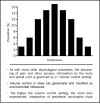The science of fibromyalgia
- PMID: 21878603
- PMCID: PMC3258006
- DOI: 10.4065/mcp.2011.0206
The science of fibromyalgia
Abstract
Fibromyalgia (FM) is a common chronic widespread pain disorder. Our understanding of FM has increased substantially in recent years with extensive research suggesting a neurogenic origin for the most prominent symptom of FM, chronic widespread pain. Neurochemical imbalances in the central nervous system are associated with central amplification of pain perception characterized by allodynia (a heightened sensitivity to stimuli that are not normally painful) and hyperalgesia (an increased response to painful stimuli). Despite this increased awareness and understanding, FM remains undiagnosed in an estimated 75% of people with the disorder. Clinicians could more effectively diagnose and manage FM if they better understood its underlying mechanisms. Fibromyalgia is a disorder of pain processing. Evidence suggests that both the ascending and descending pain pathways operate abnormally, resulting in central amplification of pain signals, analogous to the "volume control setting" being turned up too high. Patients with FM also exhibit changes in the levels of neurotransmitters that cause augmented central nervous system pain processing; levels of several neurotransmitters that facilitate pain transmission are elevated in the cerebrospinal fluid and brain, and levels of several neurotransmitters known to inhibit pain transmission are decreased. Pharmacological agents that act centrally in ascending and/or descending pain processing pathways, such as medications with approved indications for FM, are effective in many patients with FM as well as other conditions involving central pain amplification. Research is ongoing to determine the role of analogous central nervous system factors in the other cardinal symptoms of FM, such as fatigue, nonrestorative sleep, and cognitive dysfunction.
Figures



References
-
- Wolfe F, Ross K, Anderson J, Russell IJ, Hebert L. The prevalence and characteristics of fibromyalgia in the general population. Arthritis Rheum. 1995;38(1):19-28 - PubMed
-
- Burckhardt CS, Goldenberg D, Crofford L, et al. Guidelines for the Management of Fibromyalgia Syndrome Pain in Adults and Children: APS Clinical Practice Guidelines Series, No. 4. Glenview, IL: American Pain Society; 2005.
-
- Goldenberg DL, Burckhardt C, Crofford L. Management of fibromyalgia syndrome. JAMA. 2004;292(19):2388-2395 - PubMed
Publication types
MeSH terms
Substances
LinkOut - more resources
Full Text Sources
Other Literature Sources
Medical

